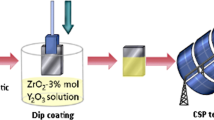Abstract
The ceramic filter in continuous casting tundish can effectively improve the cleanliness of high-performance steel by regulating tundish flow field to promote the removal of inclusions and adsorbing or blocking fine inclusions in the molten steel into the mold. The interaction between microporous magnesia refractories used as tundish filter and molten interstitial-free (IF) steel at 1873 K was investigated to reveal the formation mechanism of their interface layer and its effect on steel cleanliness by laboratory research and thermodynamic calculations. The results show that the magnesium–aluminum spinel layer at the interface between the molten IF steel and the microporous magnesia refractories is formed mainly by the reaction of MgO in the refractory with the [Al] and [O] in the molten steel, significantly reducing the total O content, the size and amount of inclusions of the molten steel. In addition, the interparticle phases of microporous magnesia refractories at high temperature can adsorb Al2O3 and TiO2 inclusions in the molten steel into interparticle channels of the refractories to form high melting point spinel, impeding the further penetration of the molten steel. As a result, the consecutive interface layer of high melting point spinel between microporous magnesia refractories and molten steel can improve the cleanliness of the molten steel by adsorbing inclusions in the molten steel and avoid the direct dissolution of refractories of the tundish ceramic filter immersed in the molten steel, increasing their service life.













Similar content being viewed by others
References
R.K. Huang, L.F. Zhang, R.B. Jiang, Y.T. Guo, W. Yang, H.J. Duan, D.B. Jiang, X.G. Zhang, Steelmaking 36 (2020) No. 6, 39–45+66.
B. Wang, R.C. Li, J.S. Liu, R.J. Cheng, H. Zhang, H.W. Ni, J. Iron Steel Res. 33 (2021) 293–301.
E.I. Mogilevskii, V.I. Burtsev, Refract. Ind. Ceram. 41 (2000) 28–30.
S.S. Feng, J.Q. Chen, Refractories. (2002) No. 4, 235–239.
X.Q. Hong, J.Z. Li, W.D. Yi, Z.Q. Song, Z.X. Lei, X.X. Yi, Refractories 46 (2012) No. 2, 81–86+95.
M. Li, W.J. Zhai, China Metallurgy 26 (2016) No. 11, 26–29.
H.L. Wang, Q.Y. Cui, Q.H. Xue, Z.H. Yan, P.T. Song, X.L. Tian, Refractories 44 (2010) No. 1, 67–70.
L. Wang, G.Q. Li, Y. Liu, Z. Zhang, Y.W. Li, X.F. Xu, J. Iron Steel Res. 29 (2017) 616–625.
W. Yan, G. Wu, S. Ma, S. Schafföner, Y. Dai, Z. Chen, J. Qi, N. Li, J. Eur. Ceram. Soc. 38 (2018) 4276–4282.
G. Wu, W. Yan, S. Schafföner, Y. Dai, B. Han, T. Li, S. Ma, N. Li, G. Li, J. Alloy. Compd. 796 (2019) 131–137.
L. Fu, H. Gu, A. Huang, M. Zhang, Z. Li, J. Am. Ceram. Soc. 98 (2015) 1658–1663.
Y. Zou, H. Gu, A. Huang, L. Fu, G. Li, Mater. Des. 186 (2020) 108326.
C. Tan, Y. Liu, G.Q. Li, C. Yuan, Y.F. Tian, Y.S. Zou, A. Huang, Steel Res. Int. 92 (2021) 2100010.
L. Fu, Y.S. Zou, A. Huang, H.Z. Gu, H.W. Ni, J. Am. Ceram. Soc. 102 (2019) 3705–3714.
Y.S. Zou, A. Huang, L.P. Fu, H.Z. Gu, Ceram. Int. 44 (2018) 12965–12972.
C. Yuan, Y. Liu, G.Q. Li, Y.S. Zou, A. Huang, Ceram. Int. 48 (2022) 427–435.
L. Chen, D.Y. Wang, H.H. Wang, T.P. Qu, A. Huang, G.Q. Li, J. Iron Steel Res. 34 (2022) 43–51.
X.Q. Yan, W. Zheng, G.W. Wang, W. Yan, G.Q. Li, J. Iron Steel Res. 32 (2020) 483–490.
J.J. Yan, W. Yan, S. Schafföner, Y.J. Dai, Z. Chen, Q. Wang, G.Q. Li, C.J. Jia, Ceram. Int. 47 (2021) 6540–6547.
Y. Ren, Y.F. Wang, S.S. Li, L.F. Zhang, X.J. Zou, S.N. Lekakh, K. Peaslee, Metall. Mater. Trans. B 45 (2014) 1291–1303.
H. Matsuura, C. Wang, G.H. Wen, S. Sridhar, ISIJ Int. 47 (2007) 1265–1274.
J.J. Chen, J.H. Liu, J.F. Liu, C.L. Zhuang, Chin. J. Eng. 33 (2011) 173–178.
F. Ruby-Meyer, J. Lehmann, H. Gaye, Scand. J. Metall. 29 (2000) 206–212.
H.X. Yu, M. Pan, D.X. Yang, Iron and Steel 55 (2020) No. 6, 46–53.
Z.Q. Li, L. Yuan, T. Liu, J.K. Yu, J. Northeast. Univ. (Nat. Sci.) 33 (2012) 1294–1298.
A. Harada, G. Miyano, N. Maruoka, H. Shibata, S.Y. Kitamura, ISIJ Int. 54 (2014) 2230–2238.
L.F. Zhang, Y. Ren, H.J. Duan, W. Yang, L.Y. Sun, Metall. Mater. Trans. B 46 (2015) 1809–1825.
Acknowledgements
The authors are grateful to the National Natural Science Foundation of China (Nos. U1860205 and 52174323) and Innovation Team Cultivation Funding Project of Wuhan University of Science and Technology (2018TDX08).
Author information
Authors and Affiliations
Corresponding author
Ethics declarations
Conflict of interest
The authors declare that they have no known competing financial interests or personal relationships that could have appeared to influence the work reported in this paper.
Rights and permissions
Springer Nature or its licensor (e.g. a society or other partner) holds exclusive rights to this article under a publishing agreement with the author(s) or other rightsholder(s); author self-archiving of the accepted manuscript version of this article is solely governed by the terms of such publishing agreement and applicable law.
About this article
Cite this article
Zhang, Ww., Zheng, W., Yan, W. et al. Formation mechanism of interface reaction layer between microporous magnesia refractories and molten steel and its effect on steel cleanliness. J. Iron Steel Res. Int. 30, 1743–1754 (2023). https://doi.org/10.1007/s42243-022-00889-y
Received:
Revised:
Accepted:
Published:
Issue Date:
DOI: https://doi.org/10.1007/s42243-022-00889-y




